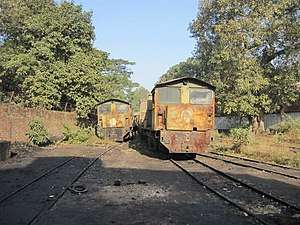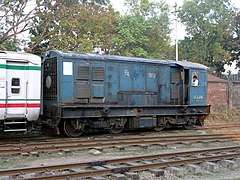Bangladesh Railway Class 3100
Bangladesh Railway Class 3100 is a class of 26 meter-gauge diesel-electric locomotives of Bangladesh, operated by Bangladesh Railway, numbered 3101 to 3126. They entered service from the middle of 1971 and were classified as MEE-5,[1] where M = Meter-gauge, E = Diesel-electric, E = English-electric and 5 = 5×100 hp = 500 hp.
| Bangladesh Railway Class 3100 | |||||||||||||||||||||||||||||||||||||||||||||||||||||
|---|---|---|---|---|---|---|---|---|---|---|---|---|---|---|---|---|---|---|---|---|---|---|---|---|---|---|---|---|---|---|---|---|---|---|---|---|---|---|---|---|---|---|---|---|---|---|---|---|---|---|---|---|---|
 Condemned locomotive class 3100 at Pahartali | |||||||||||||||||||||||||||||||||||||||||||||||||||||
| |||||||||||||||||||||||||||||||||||||||||||||||||||||
| |||||||||||||||||||||||||||||||||||||||||||||||||||||
| |||||||||||||||||||||||||||||||||||||||||||||||||||||
| |||||||||||||||||||||||||||||||||||||||||||||||||||||
Description

The Class 3100s were ordered by the Pakistan Eastern Railway in 1971, that became the Bangladesh Railway. They were of the hood type with a full-width driving cab at one end. The very short overall length of 28 ft (8.534 m) helps visibility in the restricted loading gauge. The locomotive is carried on two cast-steel bogies designed to negotiate curves of 358 ft (109.118 m) radius. A direct-coupled DC generator transmits power from a four-cylinder pressure-charged engine to four axle-hung traction motors which drive the wheels through straight spur gears.
The fabricated underframe designed to meet the 150 long tons (152.4 t; 168.0 short tons) buffing load requirement has solebars of rolled steel section 17 inches (430 mm) deep, with main cross-members at bogie pivots, engine and generator mountings. The whole surface of the underframe is enclosed by steel plate, with platform and steps surfaced with non-slip tread. ABC couplers and drawgear are mounted at a height of 22 inches (560 mm)) from the rail. The underframe carries a 400 imp gal (1,800 L) fuel tank and sand boxes serving the four outer wheels through pneumatic ejectors. The steel hood unit is divided into four compartments housing radiator, ancillary equipment, engine and generator, each having weather-sealed removable or hinged access hatches.
Steps up from the rail provide access to both side platforms, which are fitted with handrails along the hood side; outward-opening aluminium doors in the cab front panels give access to the cab from the platform plates. The interior of the cab roof is insulated and lined and a ventilating fan is provided. Driving controls are duplicated at each side of a central driver's desk, which also contains a range of instruments and surmounts the main control-gear cubicle. Two upholstered seats hinged from the cab sides, windscreen wipers and sun visors are provided.
Each bogie is a one-piece cast steel H frame with primary suspension consisting of coil springs in pockets above the axleboxes. Hydraulic dampers are fitted, but neither secondary suspension nor bogie intercoupling were considered necessary for a low-speed locomotive operating on shunting and transfer duties. Westinghouse air operated brake gear is fitted and wheels are of rolled steel solid type.
The English Electric 4SRKT MkII four-cylinder turbocharged diesel engine, normally rated at 550 hp (410 kW) at 850rpm, is set to 500 hp (370 kW) to suit the hot, humid conditions normal in this service. It is unit-mounted with a Type EE824 six-pole DC generator continuously rated at 600A at 530V. The fabricated rolled steel frame incorporates battery field, commutating and starting windings. Class F insulation is used for main fields and Class H insulation is used both for the interpoles and the armature. The commutator uses silver-bearing copper segments with mica splitters on epoxy-glass insulated Vee rings. A bulkhead across the generator forms a separate generator compartment, which houses an auxiliary control gear cubicle next to the cab.
The radiator compartment houses a single radiator panel comprising both cooling water and lubricating oil sections. The radiator fan is mounted integrally behind the panel and is directly belt-driven from an engine-shaft extension. The fan draws air through the radiator panel discharging it through grilled openings in the compartment sides. A water tank of 18 imp gal (82 L) capacity, with level gauge and low-water warning device, is mounted in the roof. The ancillary compartment houses a Westinghouse E25B compressor unit and combined auxiliary generator and traction motor blower unit, both of which are belt-driven from a pulley on the radiator fan drive-shaft. A vacuum exhauster also located in this compartment is electrically driven.
Ventilation louvres and 2 in (50.8 mm) thick gel-oil-wetted metal filters are mounted on the generator and ancillary equipment side doors. The engine draws air through these primary filters and then through a secondary dry panel filter mounted on the bulkhead. The blower unit draws air from the filters in the panel sides feeding it to the four traction motors through ducts and flexible bellows. The main generator discharges air into the engine room. The engine crankcase breather is piped to the engine compartment roof, where the engine exhaust also discharges after passing through the turbocharger.
The four Type EE549 four-pole traction motors, continuously rated at 300A, 265V, 474rpm, are axle-hung in sleeve bearings and nose suspended by springs. Class H insulation is used for both field and armature windings. The control system is based on the very simple, robust and reliable equipment originated by English Electric, as is fitted to over 1500 diesel-electric shunting locomotives in service in various countries. Engine shutdown occurs if water temperature becomes too high or coolant level is too low, oil pressure is too low or engine overspeeds. Traction motor overload is prevented by relays which open if maximum current is exceeded. Automatic wheelslip is controlled by a relay which de-energises the governor override solenoid, bringing the load regulator towards minimum field. There is also provision for automatic sanding under slip conditions.[2][3]
Usage
These 26 locomotives were only used for shunting purpose. Currently all are withdrawn from service.
References
- "Analysis of Problems" (PDF). Bangladesh Railway.
- EE-AEI metre-gauge diesels for light track in Pakistan Modern Railways April 1971
- Pakistan Eastern buys 500hp metre-gauge shunters Railway Gazette International March 1971
External links
![]()